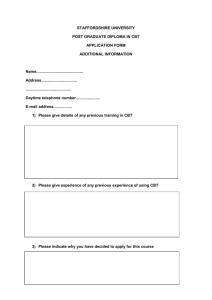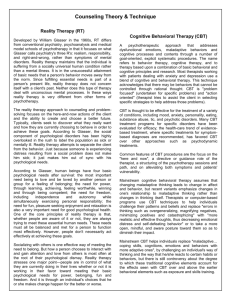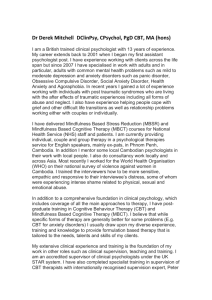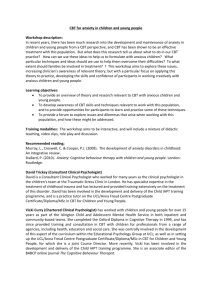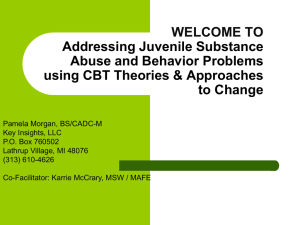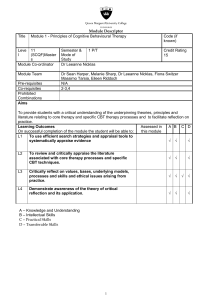Understanding & Using CBT In The Classroom
advertisement
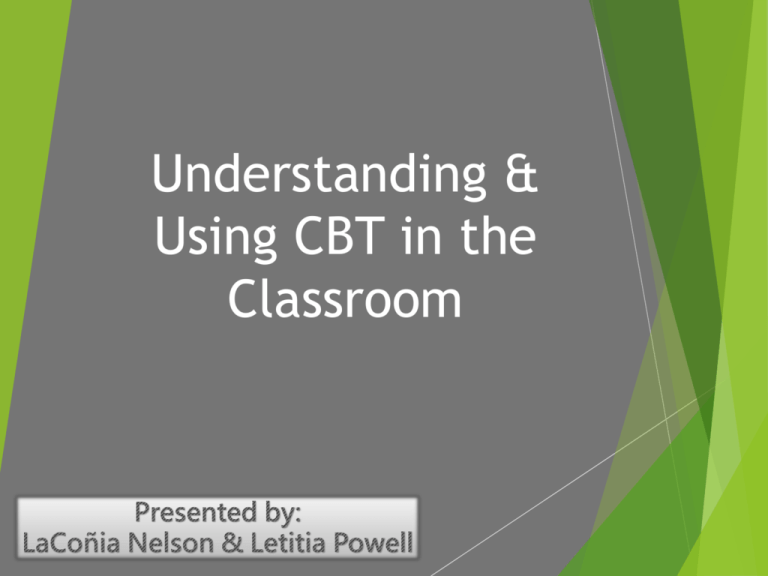
Understanding & Using CBT in the Classroom Agenda: 1. Do First (10 minutes) 2. Definition Cognitive Behavior Therapy (CBT) & Multicultural Component (3 minutes) 3. Students & Benefits (2 minutes) 4. Terms and Basic Concepts (10 minutes) 5. CBT Overview & Understanding the students you serve (20 minutes) 6. Evidenced Based Research, Student Stages & Common Goals (15 minutes) 7. CBT Implementation & Classroom Scenarios (20 minutes) 8. Resources & next steps (5 minutes) 9. Questions (5 minutes) Do First: 1. Complete the steps in the video as they are given. 2. Share take-away from Automatic Thoughts with your neighbor http://www.youtube.com/watch?v=m2zR A5zCA6M Definition of Cognitive Behavior Therapy (CBT) _____________ _____________ _____________ (CBT) is an extended combination between cognitive therapy and behavior therapy. “Cognitive behavior therapy and social learning theory now represent the mainstream of contemporary behavior therapy.” (Corey, 2009, pg. 236) CBT is a problem focused and goal oriented approach that is most knowingly used with clients who exhibit maladaptive behaviors and disorders associated with moods, depression or anxiety, personality, substance abuse, etc. Multiculturalism Multicultural counseling competence is an essential component of counselor education programs (Rowell & Benshoff, 2008). Multicultural counseling competencies provide a framework of attitudes, beliefs, knowledge, and skills which are critical for the training of effective counselors (Rowell & Benshoff, 2008). In ______________________, it is essential that counselors understand their own biases and to become aware of their own assumptions and values. Counselors should also understand culturally different clients and develop appropriate techniques and intervention strategies. AMCD Multicultural Counseling Competence Counselor Awareness of Own Cultural Values and Biases Counselor Awareness of Client’s Worldview Culturally Appropriate Intervention Strategies Who are the students? Students with: __________ Concerns __________ Concerns Students with _____ history of behaviors Students with: Anxiety Disorder Eating Disorder Depression Conduct Disorder ADHD Oppositional Defiant Disorder Benefits of using CBT Interventions with Students Effective Short-term Solution focused Can be used in school and home Terms and Basic Concepts CBT Overview Cognitive behavior therapy (CBT) assumes behaviors are learned, and with learning processes, different behaviors can be learned. (Hecker & Wetchler, 2003) The goal of CBT is to ____________ symptoms (negative behaviors) and promote appropriate behavioral responses using various methods or interventions such as: systematic desensitization, relaxation, positive and negative reinforcement, cognition modification, assertiveness training, stress management, and problem-solving. (Leichsenring, Hiller, Weissberg, & Leibing, 2006) The key concepts of CBT are the view of human nature and emotional disturbance and the A-B-C framework according to Corey (2009). CBT Overview ___________ and ___________ are connected to the situation that occurred or the comment that was made (Mennuti & Christner, 2012). It is based on the student’s perception and interpretation. CBT Overview There is not always a cause and effect; instead, it may be situational (Mennuti & Christner, 2012). CBT focuses on how the student perceives his/her experiences and how his/her perceptions influence the student’s behavior (Mennuti & Christner, 2012). CBT Overview CBT is has a lot of ___________________ and requires a great deal of student participation. CBT techniques and interventions are taught and practiced in school, and then given as homework to the student to carry out and practice at home. _____________ Involvement There are no set number or specifically identified approaches or interventions. CBT Overview Situational Behavioral Problem Cognitive Affective/ Physiological (Mennuti, Christner, & Freeman, 2012) CBT Overview Things to consider: Environmental Influences Cultural Influences Chronological Age versus Developmental Age Risk Factors Motivation to Change Desired Outcome CBT Overview Process: Combine ___________ and _____________ components to understand the student. Explore ________________ influences (i.e. past trauma, parental interaction, teacher interaction, peers, etc.) Explore the option of the problem being the result of a student with socially awkward behaviors due to underdeveloped social skills. Develop strategies or interventions that will address the issue Common Distortive Thoughts Dichotomous thinking Personalization Overgeneralization Should/Must statements Mind reading Comparing Emotional reasoning Selective abstractions Disqualifying the positive Labeling Catastrophizing (Mennuti, Christner, & Freeman, 2012) Understanding the Students You Serve SES ___________ Dynamic Parents (married), Mom/Dad (divorced) Grandparent(s), other family members Adopted ____________ Style Authoritative/Permissive/ Authoritarian/Hands-off Student’s place in family genogram Only child/middle child/oldest child/youngest child __________ abuse seen by child Child abuse Drug/alcohol related activity ________ of close loved one Evidenced-Based Research says: Cognitive Behavioral Parent Programs for the Treatment of Child Disruptive Behavior Therapist emotional reactions and client resistance in cognitive behavioral therapy Group cognitive behavior therapy for children with highfunctioning autism spectrum disorders and anxiety: A randomized trial Students’ Stages Thoughts ~ Behaviors ~ Feelings Pre-contemplation Action Contemplation Maintenance Preparation for Action Relapse Common Goal Individualize Approach Establish a relationship Student/Teacher/ Counselor Common Goal Session/ Classroom structure Case Conceptualization (Mennuti, Christner, & Freeman, 2012) Classroom Implementation & Scenarios Classroom Implementation _______ a rapport that leads to a trusting relationship is important in CBT. Not only should you get to know your students’ academic history, but also their environmental and cultural influences (see slide 18). This takes time, but it will benefit all parties. _______ with students to create classroom rules, expectations, and consequences. Students tend to honor rules, expectations, and consequences when they help create them. Take time at the beginning of the year/semester to solicit feedback from your students on how to contribute to their learning and own their actions in the classroom. Post the rules, expectations, and consequences in multiple places around the room as a reminder. Teach students key terms and use them throughout the day. (offtasks, irrational, self-monitoring, re-thinking, etc.) Consistency in key for the success of CBT strategies. Teach and refer (often) to the steps that challenge their irrational thoughts or behaviors. Classroom Implementation Create a ______ place for students to share their thoughts or feelings. For example—students can write their thoughts on a note card or the worksheet/assignment given to the teacher (see attached resources). Share this as an option, but explain there should be signs of an attempt to complete the task. For those who choose to abuse the process, let them know they may have an alternate assignment which requires more time and attention. Classroom Implementation Make time to __________ the needs of the student. Make time to follow up with the students who has expressed ___________ thoughts. (Before school, after school, phone call home, etc.) Have a color coded system that students can use to address what their __________ needs are at the time. If student is uncomfortable with using the color coded system, you may be able to create other signs that communicate certain needs. Classroom Implementation ____________ Involvement is important with CBT. Inform parents of the classroom rules, expectations, and consequences created by their student. Inform parents of the different ways they can support the use of CBT at home. Asking parents to help students identify irrational thoughts/behaviors. ___________ general problem solving, communication, and social skills. Developing household rules with the help of student ___________ desired behaviors Helping students complete CBT homework assignments (for example the if, then worksheet). Classroom Implementation Other classroom supports Peer Buddy Remove obstacles and/or distractions Provide classroom based incentives Close communication between home and school Close communication with school counselor(s) Classroom Implementation Counselor and __________ Partnership Keep counselor informed regularly. Ask counselor to teach a guidance lesson on CBT strategies (to students and teachers) Ask counselor to observe the class to ensure strategies are being implemented correctly. ________________ with counselor if individual students need additional support for their behavior. Classroom Implementation Steps What am I suppose to do? (Identify the problem) I need to figure out what to do (at least three alternatives) Solutions Self Talk Relaxation Problem Solving ___________ Think of benefits of positive behavior/thoughts What will happen if I do this? Make a __________ Find out how I did Implementing CBT with Students Thoughts ~ Behaviors ~ Feelings Changing from: I’m a failure. I can’t do this so I give up! I can’t touch anything without breaking it. Bad things ALWAYS happen to me. It means I’m a bad person. She didn’t speak to me when she passed by me. She doesn’t like me. Changing to: I didn’t get it this time, but if I keep trying then eventually I will. I need to be more careful, pay attention and watch my surroundings. Then I won’t break as many things. Some people have it worse than I do, and I always get through what happens to me. So that makes me a strong person. Maybe she didn’t see me or she has something on her mind. It has nothing to do with me. Resources & Next Steps See hand-outs Protocol of interventions & next steps 1. Try using CBT with students in the classroom or Content mastery setting 2. Contact School Counselor 3. Contact Parent References Arredondo, P., Toporek, M. S., Brown, S., Jones, J., Locke, D. C., Sanchez, J. and Stadler, H. (1996). Operationalization of the Multicultural Counseling Competencies. AMCD: Alexandria, VA. Retrieved October 2, 2013 from: http://www.counseling.org/docs/competencies/multcultural_competencies.pdf?sfvrsn=3 Children’s Service Practice Notes. (2014). Retrieved from: http://www.practicenotes.org/v15n2/EBP-2.htm Corey, G. (2009). Theory and Practice of Counseling and Psychotherapy (8th ed.). Belmont, CA: Thomson Brooks/Cole. Cully, J. A., & Teten, A. L. (2008). A therapist’s guide to brief cognitive behavioral therapy. Houston, TX: South Central Mental Illness Research, Education, and Clinical Center. Gavita, O. A., Joyce, M. R., & David, D. (2011). Cognitive Behavioral Parent Programs for the Treatment of Child Disruptive Behavior. Journal Of Cognitive Psychotherapy, 25(4), 240-256. doi:10.1891/0889-8391.25.4.240 Hecker, L.L., Wetchler, J.L. (Eds.). (2003). An introduction to marriage and family therapy. New York: Routlege Taylor & Francis Group. Leichsenring, F., Hiller, W., Weissberg, M., & Leibing, E. (2006). Cognitive-Behavioral Therapy and Psychodynamic Psychotherapy: Techniques, efficacy, and indications. American Journal of Psychotherapy, 60(3), 233-259. Mennuti, R.,B., Christ, R.W., & Freeman, A. (Eds.). (2012). Cognitive Behavioral Interventions in Educational Settings: A Handbook for Practice (2nd ed.). New York, NY: Taylor & Francis. References continued… Miller, L. D., Short, C., Garland, E., & Clark, S. (2010). The ABCs of CBT (Cognitive Behavior Therapy): Evidence-Based Approaches to Child Anxiety in Public School Settings. Journal Of Counseling & Development, 88(4), 432-439. PsychologyTools. (2014). Retrieved from: http://www.psychologytools.org/cbt.html Reaven, J., Blakeley-Smith, A., Culhane-Shelburne, K., & Hepburn, S. (2012). Group cognitive behavior therapy for children with high-functioning autism spectrum disorders and anxiety: A randomized trial. Journal of Child Psychology and Psychiatry, 53(4), 410-419. doi:10.1111/j.14697610.2011.02486.x Reeves, M. A. (2012). Cognitive-behavioral strategies for children: Evidenced-based interventions for the school setting. Rowell, P.C., & Benshoff, J.M. (2008). Using personal growth groups in multicultural counseling courses to foster student’s ethnic identity development. Counselor Education & Supervision, 48(1), 2-15. Ruffolo, M. C., & Fischer, D. (2009). Using an evidence-based CBT group intervention model for adolescents with depressive symptoms: lessons learned from a school-based adaptation. Child & Family Social Work, 14(2), 189-197. doi:10.1111/j.1365-2206.2009.00623.x Squires, G., & Caddick, K. (2012). Using group cognitive behavioural therapy intervention in school settings with pupils who have externalizing behavioural difficulties: an unexpected result. Emotional & Behavioural Difficulties, 17(1), 25-45. doi:10.1080/13632752.2012.652423 Therapist Aid. (2015). Retrieved from: http://www.therapistaid.com/ Westra, H. A., Aviram, A., Connors, L., Kertes, A., & Ahmed, M. (2012). Therapist emotional reactions and client resistance in cognitive behavioral therapy. Psychotherapy, 49(2), 163-172. doi:10.1037/a0023200
